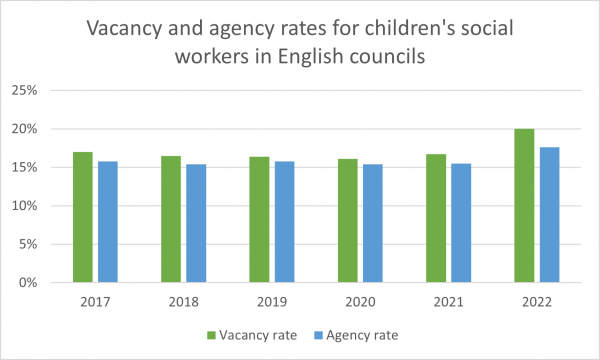
The number of frontline children’s social workers employed by English councils or children’s trusts has tumbled by 8% since 2020, official data shows.
The Department for Education’s annual workforce census, released today, showed that the number of permanent full-time equivalent (FTE) practitioners recorded as “case holding” – a group that excludes senior practitioners and managers – fell from 16,139 to 14,910 in the two years to September 2022.
All other roles saw growth over this time, with the biggest percentage increase (19%) being among senior managers who are registered as social workers.
After year-on-year growth in the number of council children’s social workers since the data started being collected in 2017, the year to September 2022 saw the first fall, with the number of FTE posts dropping by 2.7%. This was driven almost entirely by the fall in the number of case holding posts, which accounted for 820 of the 868 lost roles.
Record levels of vacancy staff and agency use
The census also showed that the proportion of vacant children’s social work posts and of roles held by agency workers had soared to their highest levels since the data started being collected.
One in five FTE posts were vacant in children’s services as of September 2022, up from 16.7% a year earlier, while the proportion of agency staff stood at 17.6%, compared with 15.5% in September 2021. Both figures are far higher than in all previous years of the data series.

Source: Department for Education children’s social work workforce census, 2022
The DfE’s measure of caseloads also increased for the first time since records began, from 16.3 to 16.6* as of 30 September 2022. The department said this was driven by a drop in the number of practitioners holding cases, as the number of cases, 335,600, was similar to the previous year.
Sickness absence also reached record levels, with 3.5% of days lost to illness in the year to September 2022, up from 3.1% the year before.
DfE workforce census 2022: key numbers
- 31,600 full-time equivalent (FTE) children’s social workers were in post in English councils as of September 2022.
- This is down 2.7% (868 FTE posts) since 2021 and the first fall since records began in 2017.
- 820 of the 868 lost posts were in case holding roles – those that held cases but were not a senior practitioner or manager.
- There were 14,910 case holding posts as of September 2022, down by 5.2% since September 2021 and 7.6% since September 2020.
- There has been growth in post numbers at all other levels – senior practitioner (up 5.5%), first-line manager (up 5.6%), middle manager (up 15.8%) and senior manager (up 19%).
- The average caseload was 16.6, as measured by the DfE, up from 16.3 the year before.
- 7,913 posts were vacant as of September 2022, up 21% (1,391 posts) on the year before.
- One in five (20%) posts were vacant, up from 16.7% in September 2021.
- 6,760 posts were held by agency workers, as of September 2022, up 13% on the previous year.
- 17.6% of posts were held by agency workers, up from 15.5% as of September 2021.
The figures illustrate the scale of the workforce challenge facing both councils and the DfE itself, as it seeks to implement its children’s social care strategy, released for consultation earlier this month.
This includes a raft of measures designed to shore up the local authority workforce, including the introduction of rules to reduce the use and cost of agency work.
However, directors of children’s services have warned that these risk coming too late to tackle the workforce pressures they are currently facing, while the vast majority of Community Care readers polled on the proposals said they were likely to lead to an exodus of agency staff, worsening current shortages.
Working conditions ‘deteriorating year after year’
In response to the DfE figures, the British Association of Social Workers (BASW) England said the DfE figures were “not a surprise” in the context of practitioners’ working conditions “deteriorating year after year”.
“Time and time again the reasons our members have given have remained consistent: unmanageable caseloads, not enough staff support and a lack of resources to truly help families, especially in early preventive services,” it said.
“Without urgent action we are risking highly motivated and experienced social workers leaving the profession, as well as risking the loss of newly qualified social workers early in their careers as they are not being supported enough to stay in the sector.”
However, the organisation warned that the DfE’s response, as set out in its consultative strategy, was inadequate, citing the £200m it has allocated over two years to implementation. This compares with the £2.6bn over four years proposed by the Independent Review of Children’s Social Care, to which the strategy is a response.
BASW England added: “Without sustained, long-term funding we fear these workforce figures will worsen, with the impact being felt most by vulnerable families.”
‘Perfect storm’
For the Association of Directors of Children’s Services, president Steve Crocker said: “We now face a perfect storm of fewer social workers, a rapid rise in vacancies and consequently caseloads increasing.”
He added: “ADCS has long raised concerns about the significant recruitment and retention pressures in the system but this is now very clearly a crisis. The children and families who we support rely on a stable workforce with a consistency of worker who knows their story and can meet their needs.
“ADCS research shows that more children are coming into contact with children’s services, we must have a sufficient, permanent workforce that can meet this rise in demand.”
Crocker reiterated the ADCS’s support for the DfE’s workforce measures, including its proposed rules on agency work, plans to recruit an additional 500 social work apprentices and measures to make social work “a more rewarding profession”.
“However, we urge the government to move at pace,” he added. “These pressures are very real. As leaders of children’s services we would certainly support a national social work campaign similar to the government’s teacher recruitment efforts. I know from my own experience that social work is a rewarding career and good social work literally changes lives. The benefits of a strong and stable workforce for children and families cannot be understated. The government must take swift and meaningful action.”
*The average caseload figure is calculated by dividing the total number of cases at the time – 335,600 in this case – by the total number of full-time equivalent registered social workers holding cases (20,200). The latter figure includes staff at all levels, including managers. As a result, the average (16.6) will be higher than the number held by most frontline practitioners.



 Bournemouth, Christchurch and Poole
Bournemouth, Christchurch and Poole  Hampshire County Council
Hampshire County Council  Lincolnshire County Council
Lincolnshire County Council  Norfolk County Council
Norfolk County Council  Northamptonshire Children’s Trust
Northamptonshire Children’s Trust  South Gloucestershire Council
South Gloucestershire Council  Wiltshire Council
Wiltshire Council  Wokingham Borough Council
Wokingham Borough Council  Children and young people with SEND are ‘valued and prioritised’ in Wiltshire, find inspectors
Children and young people with SEND are ‘valued and prioritised’ in Wiltshire, find inspectors  How specialist refugee teams benefit young people and social workers
How specialist refugee teams benefit young people and social workers  Podcast: returning to social work after becoming a first-time parent
Podcast: returning to social work after becoming a first-time parent  Podcast: would you work for an inadequate-rated service?
Podcast: would you work for an inadequate-rated service?  Family help: one local authority’s experience of the model
Family help: one local authority’s experience of the model  Workforce Insights – showcasing a selection of the sector’s top recruiters
Workforce Insights – showcasing a selection of the sector’s top recruiters 

 Facebook
Facebook X
X LinkedIn
LinkedIn Instagram
Instagram
I don’t believe anyone has a caseload of under 17. In our local authority you’re lucky if it’s under 27, and we’re not the worst by any means.
Facts!! the average case load is 16 or less ?!! Really …. ??
Same in every authority. I don’t know how the DfE manage to get these daft figures every year for caseloads. They use averages from figures taken on one day of the year only. Including those who have just started so have a case load of 2 or who are just back from sickness and have a caseload of 3 and this brings the averages down making it look like everyone has 16 instead of 10 people with 30, 11 with 27, 7 with 8, 3 with 2 and so forth. The sickness is a nonsense as well. I don’t think caseloads have ever been lower on average than 24 in places I have worked and I know plenty of social workers with cases of 30 and some with more again.
Vacancies and lots of them generate Departmental underspend.
Where’s the money being spent?
What are the pre-election shifts in the narratives of social work, who’s voices are really being heard and is this in keeping with the Code of Ethics?
Cpd, eh!
Crude measures of totals don’t work.
Aggregation of this type is a misrepresentation of the real world creating distorted views of a profession that are inherently unhealthy.
I’ve held ‘caseloads’ way in excess of these aggregates while also employing others with ‘caseloads’ of 5-6.
The machine world assumption that one can measure the immeasurable fails everyone. As an advanced economy the provision of universal services is an expected competency.
How this expectation is met is though ideological. As yet there isn’t evidence of sufficient reflexivity in how the organisation of organisations will provide long-term benefits to society. That’s why LASSA was crafted in the terms it was.I have had the good fortune of meeting and working with the authors of this statute. All are long-ago retired if not dead. Is LASSA dead too. Discuss.
Sorting out the societal value of social work, perhaps as a means to mesoscopic evaluation methodology, in-between the micro-macro economic activity, in-between the agency v permanent staff or Council v RCCs is needed. Social Work occupies this third space and always has. The competency needed to initiate this conversation exceeds that which I have. I am suited to chaos. Knowing this is about our own adult developmental learning and not about changing the brand of Leadership and Management Training.
For CPD see the work of Otto Laske. Otto was a student of Theodore Adorno and Jurgen Habermas both of whom wrote extensively about the Authoritarian Personality as a response against Fascist thought. There are also countless Black and Asian perspectives that colleagues in IFSW can share.
Sorting out the legacy of a white middle class hegemonic influences is our collective responsibility. If we don’t, and we’ve been given plenty of time to do it, the mechanisms of market forces will inevitably to used.
Q: Do we Care? LASSA is dead. Long live LASSA. Discuss.
I have got social worker decree but I cant get ASYE to become senior social worker. So many people are in this position as me. You are saying you are short of social workers Make Asye available to people who have complete their decree. I think they need to look into this and make sure every body have access to complete ASYE.